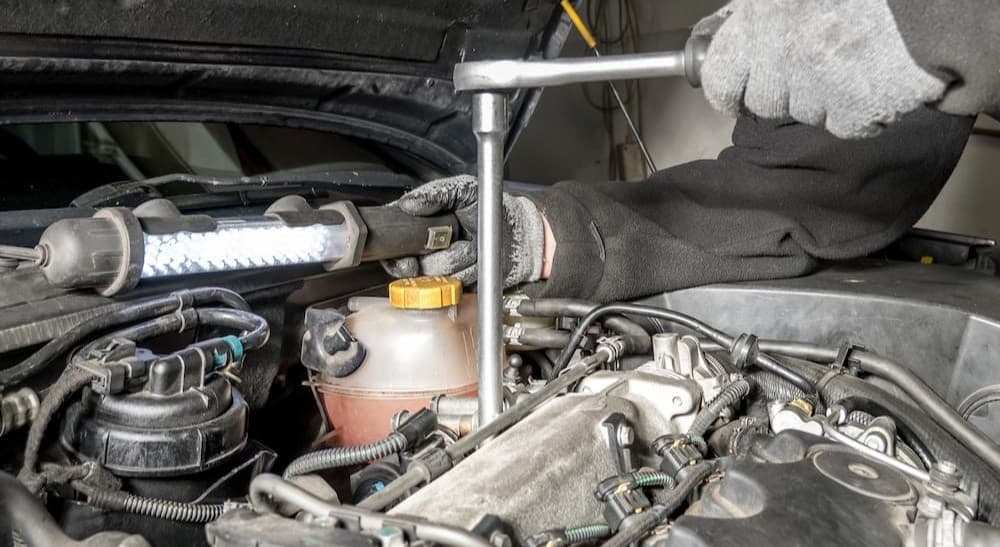We all know that the best way to get the most from your vehicle is to take proper care of it, and proper care means knowing your vehicle’s maintenance schedule and sticking to it. That being said, what you tend to see people talk about the most is basic things like getting an oil change every 7,500 miles and changing your cabin air filter every couple of years. If you’re leasing your vehicle, then those are probably the only things you’ll really need to worry about, but if you own a car, truck, or SUV, then there are long-term types of maintenance that you should keep in mind.
Whether you like to work on your vehicle yourself or you need to know when to schedule your next visit to your preferred auto repair shop, understanding your vehicle’s service schedule is essential. Don’t just trust whatever a mechanic tells you—they might be trying to fit an extra visit or two in, after all. Know your vehicle’s schedule and stick to it, looking beyond just the yearly stuff so you know what to expect after three years and beyond.
Proper maintenance in the long term keeps your vehicle running great and can help you avoid much bigger problems. For simplicity’s sake, we’re going to refer to the 2022 Chevy Silverado 1500 as an example, but be sure to check the schedule for your specific model—in your owner’s manual—as these figures only apply to this particular vehicle.
Replace Spark Plugs
This is an interesting place to start because most people have heard of the spark plugs in their vehicles and likely know about replacing them. Personally, I have a very distinct childhood memory of my father working on his car and specifically needing to change spark plugs in the engine of his Camaro—and yet, this isn’t an issue that should come up very often, despite how prevalent it seems to be in pop culture.
Your spark plugs should last a long time; unless there’s a problem with them, you won’t need to worry about them for several years. Looking at the 2022 Silverado 1500, for example, Chevy says to replace the spark plugs after 60,000 miles with the standard turbo engine or at 97,500 miles with one of the available V8 engines. On average, that’s about five years of use with the turbo engine or about eight years of driving with the other two engines. For something that seems to be such a major issue on TV shows and movies, spark plugs won’t come up nearly as often as you might expect and are more of a long-term service consideration.

Change Transfer Case Fluid (4WD)
If you have a vehicle with four-wheel drive (4WD) or all-wheel drive (AWD), then you have a transfer case, which transfers power from the transmission to the front and rear wheels. This is a gearbox, and a lot of heat gets generated while it does its thing, which means it needs lubrication to keep that heat under control, just like your engine.
The transfer case fluid is like your motor oil, but it’s for the transfer case, so it’s vital to ensure your 4WD or AWD vehicle performs well and doesn’t destroy itself. For the Silverado 1500, Chevy says to change the transfer case fluid every 97,500 miles. Compared to something like engine oil, this can clearly last a lot longer, but it’s an important thing to have in mind while enjoying a vehicle with AWD or 4WD.
Change Engine Cooling Fluids
Just in case you didn’t know, your engine gets hot. (Yeah, I know, right?) Thousands of fiery explosions occur every time you get behind the wheel—and while your engine is designed to handle that abuse, it still needs help keeping things cool. That’s where your vehicle’s radiator and coolant fluid come into play, running through part of your engine to transfer heat away from it and keep things at a temperature it can handle.
Assuming no other issues come up with your radiator, you need to occasionally drain the fluid from it and then refill it with fresh coolant. Looking at the 2022 Silverado 1500, Chevy has this listed for every 150,000 miles or every five years, whichever comes first. As long as your radiator is good and none of your hoses spring a leak, you can go a long time without worrying about your coolant, but it’s an important long-term consideration.
Inspect/Change Drive Belts
There are a fair number of drive belts under the hood of your car, which compel moving parts and send power to different components throughout your vehicle. Accessory belts can drive things like the air compressor for your car’s A/C system, power the pump for your radiator and cooling system, send power from the engine to your alternator, and more. These belts take a lot of abuse, and while they’re designed to do so, they still need to be checked every so often. Chevy says to have them inspected every 150,000 miles or every ten years—whichever comes first—and to replace them if they’re fraying, cracking, or otherwise damaged.
Replace Brake Fluid
The brakes on your vehicle function thanks to hydraulic pressure, which allows you to apply relatively small amounts of force to a brake pedal that ultimately applies much greater force to your brakes to stop your vehicle. This hydraulic pressure relies on fluid in your brakes, which should last a long time, assuming no other issues come up. All things being equal, Chevy indicates the brake fluid on the 2022 Silverado 1500 should be replaced every five years without a mileage guideline. Of course, if you’re having problems with your brakes, then you might need to replace the fluid much sooner.

Change Automatic Transmission Fluid and Filter (Severe Use)
One final thing to note is that manufacturers often provide different guidelines for service intervals if you tend to put more use on your vehicle. For example, Chevy has Normal guidelines and a Severe schedule for services, which applies to a vehicle mainly driven in heavy city traffic in hot weather, driven in hilly and mountainous terrain, used for towing, or used for professional functions like delivery and ride-sharing.
Chevy’s service interval for the 2022 Silverado 1500 includes changing the automatic transmission fluid and filter for a vehicle used in these severe conditions every 45,000 miles. Interestingly, there’s no entry for changing the automatic transmission fluid and filter for Normal use, only Severe. So, general use in moderate weather means the automatic transmission fluid will likely last the lifetime of this Silverado, assuming no other issues arise.
It’s also important to note that the Severe service schedule moves things up in some ways, such as the transfer case fluid for 4WD vehicles, which should be changed every 45,000 miles under such conditions. This is why it’s important to become familiar with the schedule for your vehicle.
Getting the Most From Your Vehicle
I want to leave you with one final note: when you look at a service schedule from a manufacturer, remember that these things are additive and indicate frequency. Chevy suggests rotating tires and checking (or changing) engine oil and oil filters every 7,500 miles. That means there are occasions where multiple things line up; for example, at 97,500 miles with the 2022 Silverado 1500, you’d need to be ready to replace the oil and filter, the spark plugs on V8 engines, and the transfer case fluid for a 4WD model.
This is something you’ll see quite often, particularly with certain milestones like 60,000 or 120,000 miles for many vehicles. My point is to look ahead and be ready for more work to be done on occasion when multiple intervals line up so you don’t get caught off guard when numerous things need to be taken care of at once.

